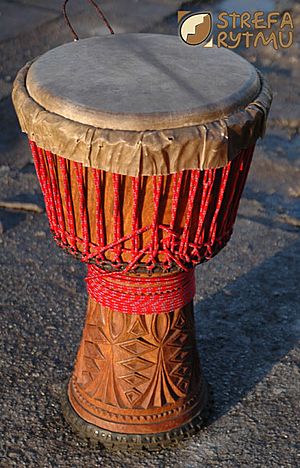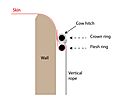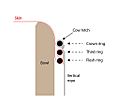Djembe facts for kids

The djembe (pronounced ZHEM-bey) is a super cool drum from West Africa! It's one of the most famous African drums around. This special drum is shaped like a big cup or goblet and is played using your bare hands. The main part of the drum is carved from a hollowed tree trunk. The top part, which you hit, is made from goat skin.
Contents
What is a Djembe Drum?
The djembe is a type of percussion instrument. It makes sound when you hit its skin head. It's known for its wide range of sounds. You can make deep bass tones, sharp slaps, and clear open tones. These different sounds make the djembe very versatile. It can be used for many kinds of music.
Where Does the Djembe Come From?
The djembe drum has a long history. It started in the Mali Empire around the 13th century. This empire was in West Africa. The djembe was created by the Mande people. They are a large group of people living in West Africa. Today, you can find djembe drums in many countries. These include Mali, Guinea, Senegal, and Burkina Faso.
How is a Djembe Made?
Making a djembe is a skilled craft.
Carving the Body
First, the body of the drum is carved. This is done from a single piece of wood. Common woods used include lenke, dugura, and iroko. These woods are strong and sound good. The inside of the drum is also carefully shaped. This helps the sound travel and resonate well.
Adding the Skin Head
Next, a goat skin is stretched over the top. This skin is usually from a female goat. It is chosen for its thickness and quality. The skin is held in place by rings and ropes. These ropes are pulled very tight. This makes sure the skin is firm. A tight skin gives the drum a clear, bright sound.
Tuning the Drum
Djembe drums are tuned by tightening or loosening the ropes. This changes the tension of the skin. More tension makes a higher pitch. Less tension makes a lower pitch. Drummers often tune their djembe before playing. This ensures it sounds just right for the music.
How Do You Play the Djembe?
Playing the djembe is exciting! You use your bare hands. Different hand positions create different sounds.
- Bass: You hit the center of the drum head. This makes a deep, low sound.
- Tone: You hit the edge of the drum head. Your fingers stay flat. This makes a clear, ringing sound.
- Slap: You hit the edge with your fingers cupped. This makes a sharp, high-pitched sound.
Learning to play the djembe takes practice. Drummers combine these sounds. They create complex and exciting rhythms.
The Djembe in Culture
The djembe is more than just a musical instrument. It's a big part of West African culture.
Traditional Uses
Historically, the djembe was used for many things. It played a role in celebrations. It was used in rituals and ceremonies. The drum also helped tell stories. It could even send messages between villages. The rhythms often have special meanings. They can tell about history or daily life.
Modern Popularity
Today, the djembe is popular worldwide. People play it in many music styles. You can hear it in traditional African music. It's also used in jazz, pop, and world music. Many people enjoy playing the djembe for fun. It's a great way to connect with rhythm and culture. Workshops and classes are common. They help people learn to play this amazing drum.
Images for kids
-
Mali Empire around 1350 AD
-
Timing belt decoration on the foot of a djembe (purchased in Conakry in 2001)
See also
 In Spanish: Yembé para niños
In Spanish: Yembé para niños





























